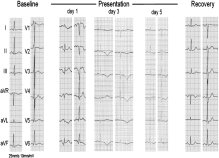The pivotal role of a pre-admission electrocardiogram for the diagnosis of Takotsubo syndrome in the ED☆
Icahn School of Medicine at Mount Sinai, New York, NY, USA
Division of Cardiology, Elmhurst Hospital Center, Elmhurst, NY 11373, USA
 Article Info
Article Info
Publication History
Published Online: December 11, 2013Accepted: December 1, 2013; Received: November 21, 2013;
To view the full text, please login as a subscribed user or purchase a subscription. Click here to view the full text on ScienceDirect.

Fig
Analysis of the ECG as in the text. (Reproduced from Fig. 1 of Ref. 7, with the permission of Elsevier).
Prompt differentiation of Takotsubo syndrome (TTS) from acute coronary syndromes (ACS) is crucial in the management of patients presenting with chest pain/dyspnea/palpitations/weakness/dizziness/presyncope/syncope in the emergency department (ED), since it is imperative that the latter receive expedited therapy with thrombolysis or percutaneous coronary interventions, while the former are cared for along the lines of symptomatic nonspecific management, until we know more about the pathogenesis of TTS [1].
To access this article, please choose from the options below
Purchase access to this article
Claim Access
If you are a current subscriber with Society Membership or an Account Number, claim your access now.
Subscribe to this title
Purchase a subscription to gain access to this and all other articles in this journal.
Institutional Access
Visit ScienceDirect to see if you have access via your institution.
☆Conflict of interest: None declared.
© 2012 Published by Elsevier Inc.
Access this article on
Visit ScienceDirect to see if you have access via your institution.
Related Articles
Searching for related articles..



